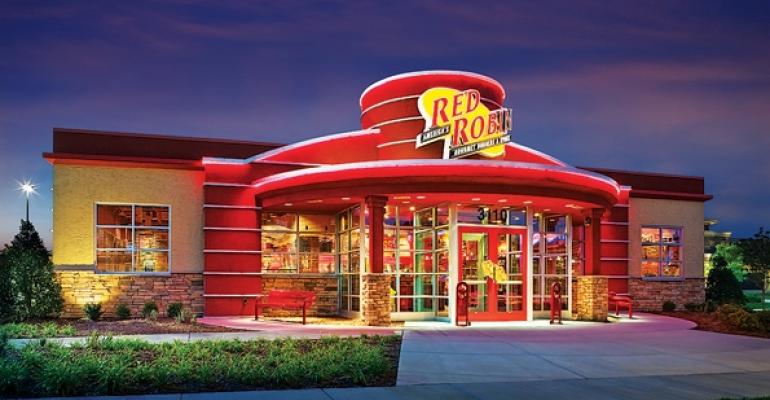Red Robin Gourmet Burgers Inc. reported a 10-percent decline in first-quarter profit on Tuesday but said an ongoing remodel program and tests of a smaller-footprint prototype are showing better-than-expected results.
Steve Carley, chief executive of the Greenwood Village, Colo.-based casual-dining chain, said the company is continuing transformation efforts to improve the guest experience and make the brand more relevant.
RELATED
• Red Robin introduces new appetizers, desserts
• The Leading Edge: Red Robin CEO, Steve Carley
• More casual-dining news at NRN.com
While value-driven promotions by competitors have been a challenge, Carley said, “Simultaneously there appears to be a growing bifurcation between brands that are relevant and differentiated and meeting guest expectations, and those that aren’t.
“Our goal,” he said, “is to serve more guests more often and leave them more delighted.”
The company has been testing upgraded units at various levels ranging from a bar-only revamp to a more comprehensive $400,000 overhaul that includes improved service and better food presentation, as well as a décor package that brings in more “elements of whimsy,” and enhanced patios.
The company is still evaluating what works, and new restaurant prototypes will be tested in two more sites this year, but Denny Marie Post, Red Robin’s senior vice president and chief menu and marketing officer, said, “We got a lot right.” The bar is a “cooler place to hang out,” she said, and efforts to build the bar business have not alienated families, for example.
Another 20 restaurants are scheduled to be remodeled this year, and Carley said some elements from the transformation effort will be pulled through the whole system. All Red Robin team members, for example, were asked to re-apply for their jobs based on new hiring specifications, he said. “Not everyone got rehired.”
In addition, since the fourth quarter last year, Red Robin has opened three smaller-footprint restaurants, which are about 4,000 square feet as opposed to the traditional 6,000-square-foot “big box” locations. Two more are under construction.
Carley said the company is very pleased with results from the smaller units, which offer more flexible real estate opportunities for the brand and have lower build-out costs while still providing the capacity for “healthy volumes.”
Of 20 new restaurants planned for 2013, seven will be the smaller units, Carley said.
The company is also planning to open “several” more of the fast-casual Red Robin Burger Works restaurants, which offer a streamlined menu and lower prices. Carley said he could not be specific about the number planned because competition is so stiff for the 2,000-square-foot end-cap locations needed, but the company is planning to continue tests of the secondary brand outside the company’s home market of Denver. The company operated five Burger Works at the end of the first quarter.
New burgers, cocktail to come
On June 4, Red Robin is scheduled to roll out a new summer menu featuring a new burger and a “first-to-market” cocktail that have not yet been revealed. Post said the company will also begin testing new premium burgers in some markets.
The new menu will be supported by a new advertising campaign, featuring the tagline “24 Burgers. A Million Reasons,” which will feature a quirky spokeswoman who Post said will appeal to adult women. “The campaign is designed to help people discover things about Red Robin,” while still allowing the chain to drop in LTO news, Post said.
For the first quarter ended April 21, Red Robin reported net income of $9.5 million, or 66 cents per share, compared with $10.6 million, or 71 cents per share, a year ago.
Systemwide revenues increased 0.6 percent to $416.6 million, compared with $414.2 million a year ago. Total company revenues, including sales at company restaurants and franchise royalties, increased 2.3 percent to $306.3 million.
At company-operated locations, same-store sales rose 2.2 percent, including a 2.8-percent increase in average check that was offset by a 0.6-percent decline in traffic.
Carley said seasonal shifts from changes in the reporting period and media timing had a negative impact on guest traffic and earnings, but the chain showed strong guest counts compared with casual dining as a whole.
Red Robin finished the quarter with 337 company-owned restaurants, five of the fast-casual Burger Works units, and 133 franchised restaurants.
For the year, Red Robin expects same-store sales growth of between 2.5 percent and 3 percent.
Contact Lisa Jennings at [email protected].
Follow her on Twitter: @livetodineout





